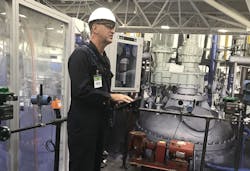We knew it would happen someday. The automation-enabled productivity improvements that have propelled our economy for the past 30 years are drying up. “Performance gains are getting smaller,” said Mike Train, executive president of Emerson Automation Solutions, speaking at the annual Emerson Global Users Exchange in Minneapolis.
The workforce reductions of recent years and process improvements have all been incorporated. If manufacturers are to move ahead, they will need to look at more than just increasing efficiency, Train said. “There’s not a lot left to cut.”
Implementing advanced technology is on the C-suite’s agenda, but notoriously bad track records—65 percent of projects over $1 billion fail to deliver, according to Train—hold them back.
Automation drives value
With headlines blaring that we’re all about to be replaced by robots, companies also need to leverage the upside of increasing automation by shifting workers from routine jobs and preparing them for more value-added roles. “After years of cutting headcount, most manufacturers are now ‘staffed to run,’ not ‘staffed to change,’” Train said.
Train believes we are at an inflection point where companies are embracing digital technology to reinvent themselves, giving them funds to reinvest in people. Research conducted by IHS in conjunction with Emerson identified a potential trillion-dollar opportunity in operational performance, he added. Top-quartile performers (those in the top 25 percent of performance among their peers) exhibit behaviors that propel them above the pack. To help everyone get onboard, Emerson has identified five key competencies as critical to realize the value of digital transformation:
- Automated workflow: Eliminate repetitive tasks and streamline standard operations to focus personnel on exceptions and other opportunities that require human intervention.
- Decision support: Leverage analytics and embedded expertise to provide actionable insights that reduce complexity and enable higher-quality, faster decision-making.
- Workforce upskilling: Identify approaches that empower workers to gain knowledge or experience faster and more effectively. This will support higher-level and collaborative decision-making.
- Mobility: Provide secure, on-demand access to information and expertise regardless of location, enabling collaborative workflows.
- Change management: Combine strategies, processes, tools and expertise that, in the right combination, simplify and accelerate the institutionalization of operational best practices.
Retraining and helping the organization accept change and embrace new roles is paramount, Train said. “Data-powered human talent will be the new linchpin of success.”
The rapid advance of technology will affect job roles. Control operators will become process optimizers. Production supervisors will have 24/7 visibility into plant operations with no more trips to the plant at 2 a.m. Data that enables breakthrough insights is the key that will enable workers to deliver greater value, Train said.
Emerson has a long-standing partnership with Ranken Technical College in St. Louis, an institution that seeks to provide the elusive technical skills that are hotly in demand. Such partnerships are building a pipeline of skilled workers by reaching out as early as middle school to attract young people to the profession. “We need to make manufacturing a rewarding career path again,” Train said.
At Emerson Exchange this week, Emerson will introduce enhancements to its Plantweb digital ecosystem portfolio, with new technologies and services aimed at workforce productivity and organizational effectiveness. An immersive experiential environment, “Digital Workforce Experience,” demonstrates how a digitally enhanced workforce behaves differently and helps transform organizations.
“The digital workforce of the future will help our customers accelerate value creation,” Train said. “It’s time to invest in both technology and people.”
About the Author
Lauren Gibbons Paul
Contributing Editor

Leaders relevant to this article:
